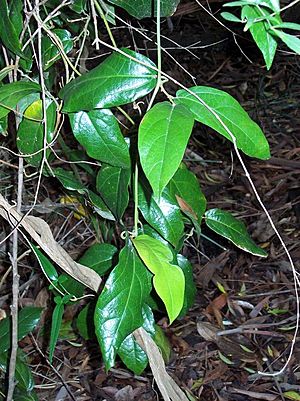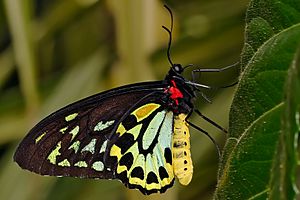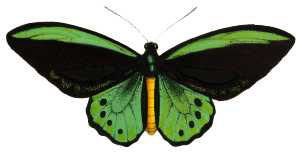Richmond birdwing butterfly vine facts for kids
Quick facts for kids Richmond birdwing butterfly vine |
|
|---|---|
 |
|
| Scientific classification | |
| Kingdom: | |
| (unranked): | |
| (unranked): | |
| Order: | |
| Family: | |
| Genus: |
Pararistolochia
|
| Species: |
P. praevenosa
|
| Binomial name | |
| Pararistolochia praevenosa (F.Muell.) Michael J.Parsons
|
|
| Synonyms | |
|
Aristolochia praevenosa |
|
The Richmond birdwing butterfly vine (scientific name: Pararistolochia praevenosa) is a special plant from Australia. It's a type of vine that belongs to the birthwort family. This vine grows in warm, wet rainforests along the coast. You can find it in northern New South Wales and southeastern Queensland. It has even been seen as far north as the Mary River. In tropical northern Queensland, it's also an important food source for the Cairns birdwing butterfly.
Contents
A Home for Butterflies
This amazing vine is the main food for the caterpillars of the Richmond birdwing butterfly. This butterfly is very important to the areas where it lives. Sadly, the places where this vine grows have been greatly reduced over time. For example, a large rainforest area called the Big Scrub has almost completely disappeared.
Because of this, many schools and government groups are now working hard to plant more of this vine. Their main goal is to help the Richmond birdwing butterfly survive and thrive. It's good to know that the butterfly caterpillars don't usually harm the vines. They only eat the fresh, new leaves and leave the older ones alone.
What the Vine Looks Like
The Pararistolochia praevenosa is a large, woody vine. It has thick, brown hairs on its stems, new shoots, and flowers.
Leaves
The leaves are shaped like an egg or an oval. They can be from 7 to 25 centimeters (3 to 10 inches) long and 2.5 to 8 centimeters (1 to 3.4 inches) wide. The bottom of the leaf is often heart-shaped or rounded. The top of the leaf is a dull, dark green. The underside is hairy, especially along the veins. The leaf stems are short, about 1 to 3 centimeters (0.4 to 1.2 inches) long, and they can be thick and twisted.
Flowers and Fruit
In summer and autumn, the vine produces groups of two to six tube-shaped flowers. These flowers are about 2.5 centimeters (1 inch) long. They are usually purple or pinkish on the outside, with a bright yellow inside. The flowers mostly grow from where the leaves meet the stem. After the flowers, the vine produces an orange, ribbed fruit. This fruit is shaped like an oblong or oval capsule and is 2 to 4 centimeters (0.8 to 1.6 inches) long.


How the Vine Grows
Tiny insects called Forcipomyia midges help pollinate the flowers of this vine. Growing new vines from cuttings can be tricky, and they grow slowly. However, it's not too hard to grow new plants from fresh seeds. The seeds can grow for about three months after they are collected.
If you want to help young vines grow strong, it's a good idea to:
- Water them properly.
- Remove any weeds around them.
- Protect them from snails.
- Give them something to climb on.
- Use fertilizer to help them get nutrients.
About the Name
The Richmond birdwing butterfly vine was first described in 1861 by a scientist named Ferdinand von Mueller. He originally called it Aristolochia praevenosa. Later, in 1996, another scientist named Parsons moved it to its current group, Pararistolochia.

